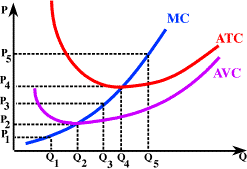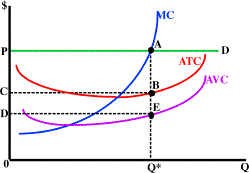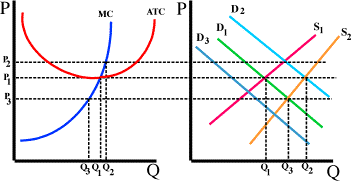Multiple Choice Questions for Perfect Competition
Make your browser window as large as possible.

- Mike's is producing baseball caps in a perfectly competitive market.
Mike's needs only workers and the factory to produce baseball
caps. It pays hourly wages to workers and rent for the factory.
Figure 1 shows the cost structure of Mike's. How many caps would Mike's
produce in the short run, if the price of a baseball cap is P1?
- Q1
- Q2
- Q3
- Q4
- 0
- Again, referring to Figure 1, if the price of a baseball cap is P5 in the short run, how many would Mike's produce? How many would
he produce in long-run equilibrium?
- Mike's would produce Q5 in the short run and Q5 in the long run.
- Mike's would produce Q5 in the short run and Q4 in the long run.
- Mike's would produce Q4 in the short run and Q4 in the long run.
- Mike's would produce Q4 in the short run and Q2 in the long run.
- Mike's would produce Q2 in the short run and Q2 in the long run.
- A firm in a perfectly competitive industry finds itself in the
following position: output =1000 units, market price = $3, total
cost = $6,000, fixed cost = $2,000, marginal cost = $3. If the
firm behaves as a profit maximizer, it should:
- should reduce output in the short run, but should increase output in the long run.
- should shut down in the long run, but continue producing output in the short run.
- should shut down in the long run, and shut down in the short run.
- should increase output in the short run, but reduce output in the long run.
- should shut down in the short run, but continue producing output in the long run.

Figure 2 - If the profit maximizing firm shown in Figure 2 is producing Q* units of output, it is operating where:
- losses equal DCBE.
- total variable costs equal area DPAE.
- profits are at their maximum value and equal CPAB.
- total fixed costs are equal to area 0DEQ*
- profits are at their maximum value and equal DPAE.
- If the firm shown in Figure 2 is producing Q* units of output, its total costs are represented by:
- the area equal to 0CBQ*.
- the area equal to 0DEQ*.
- the area equal to CPAB.
- the area equal to DCBE.
- the area equal to DPAE.
- If the firm shown in Figure 2 is producing Q* units of output, its total variable costs are represented by:
- the area equal to 0CBQ*.
- the area equal to 0DEQ*.
- the area equal to CPAB.
- the area equal to DCBE.
- the area equal to DPAE.
Note: Questions 7 through 9 are about the market for thick, heavy, hot wool socks (the kind you would only wear when it's very cold). Suppose this is a perfectly competitive industry.
- Suppose the market for thick, heavy, hot wool socks is in long
run equilibrium. Now suppose the greenhouse effect kicks in with
a vengeance raising average temperatures all over the planet.
In the short run you predict:
- higher prices and greater output of wool socks.
- increased profits for wool sock firms.
- lower prices, lower quantities and higher profits for wool sock firms.
- lower prices, lower quantities and losses for wool sock firms.
- lower prices, lower quantities and zero profits for wool sock firms.
- As a result of the short run effect on the wool sock industry
caused by global warming, the adjustment to long run equilibrium
will consist of:
- firms entering the industry due to increased profits, shifting the marginal and average total cost curves out until profits are zero.
- firms leaving the industry due to losses, shifting the marginal and average total cost curves out until profits are zero.
- firms leaving the industry due to losses, shifting the industry supply curve out until prices fall enough to ensure zero profits.
- firms leaving the industry due to losses, shifting the industry supply curve back until prices rise enough to ensure zero profits.
- firms entering the industry due to increased profits, shifting the supply curve out until profits are zero.
- Comparing the new long run equilibrium in the wool sock industry
with the original one, you expect to find that:
- There will be fewer firms, with each firm charging the same price and producing the same output as in the original equilibrium.
- There will be fewer firms, with each firm charging a lower price and producing less output than in the original equilibrium.
- There will be more firms, with each firm charging a lower price and producing less output than in the original equilibrium.
- There will be more firms, with each firm charging the same price and producing the same output as in the original equilibrium.
- There will be fewer firms, with each firm charging a higher price and producing less output than in the original equilibrium.

Figure 3 - Consider the profit maximizing perfectly competitive firm shown
in Figure 3. If this firm is producing an output of 10 units, it's total costs
will be:
- $150.
- $20.
- $15.
- $50.
- $200.
- Consider the profit maximizing perfectly competitive firm shown
in Figure 3 If this firm is producing an output of 10 units, it's total variable
costs will be:
- $150.
- $20.
- $15.
- $50.
- $200.
- Consider the profit maximizing perfectly competitive firm shown
in Figure 3. This firm's total fixed costs will be:
- $150.
- $20.
- $15.
- $50.
- $200.
- Consider the profit maximizing perfectly competitive firm shown
in Figure 3. If the market price is $20 the firm will produce:
- 5 units.
- 7 units.
- 8 units.
- 10 units.
- 12 units.
- Again consider the firm shown in Figure 3. At the price of $20 the firm will earn:
- profits of $42.
- profits of $50.
- losses of $50.
- losses of $42.
- profits of $40.
- When the industry is in long run equilibrium the firm shown in
Figure 3 will:
- produce an output of 10 units at a price of $20.
- produce an output of 5 units at a price of $10.
- produce an output of 8 units at a price of $15.
- produce an output of 7 units at a price of $14.
- produce an output of 12 units at a price of $20.
Note: Questions 16 through 18 are about the plastic knob industry. Suppose this industry is perfectly competitive and that petroleum is an important ingredient in the manufacture of plastic. You may find it stabilizes your thinking to sketch graphs. Questions about specific firm behavior refers to firms that were in the industry all along, not to firms that entered or exited during any market adjustments.
- Suppose that the price of petroleum increases. In the short run
within individual firms in the plastic knob industry we would observe that:
- price increases, output falls, and firms incur losses.
- price falls, output increases, and firms incur losses.
- price falls, output increases, and firms earned zero profit.
- price stayed unchanged, output falls, and firms incur losses.
- price stayed unchanged, output rises, and firms incur losses.
- In the long run, due to the increase in the price of petroleum, what would we
expect to observe within individual firms in the plastic knob industry relative to the short run equilibrium which occurred after petroleum prices rose? (Do not
compare relative to the initial equilibrium before petroleum prices
rose.)
- prices rise, output falls, losses shrink.
- prices rise, output increases, losses shrink.
- price fall, output increases, and profits grow.
- price fall, output falls, and losses grow.
- price stay unchanged, output falls, and losses grow.
- Finally, in comparing the new long run equilibrium with the initial long run equilibrium we would observe the following changes in the plastic
knob industry.
- fewer firms, higher price.
- fewer firms, same price.
- fewer firms, lower price.
- more firms, same price.
- more firms, higher price.
- The long run supply curve for a perfectly competitive industry
may be horizontal, upward sloping or downward sloping depending
on certain factors. Suppose the CD-ROM Reader manufacturing industry
is perfectly competitive. Under which of the following conditions
will the CD-ROM Reader industry have a downward sloping long run supply curve? (A CD-ROM (Compact Disc Read Only Memory) reader is a computer
peripheral (accessory) which allows the computer to read data
from a CD-ROM disk similar to those which are used for music.
These days most software is distributed on CD-ROMs Most CD-ROM
readers can play music CDs as well. By the way, they were available
for the Macintosh well before they were for Windows machines.)
- As more CD-ROM Reader manufacturing firms enter the industry, those firms which supply motors to the CD-ROM Reader manufacturing firms find demand for their product rising and their per unit production costs rising.
- As more CD-ROM Reader manufacturing firms enter the industry, those firms which supply motors to the CD-ROM Reader manufacturing firms find demand for their product rising and their per unit production costs falling.
- As more CD-ROM Reader manufacturing firms enter the industry, more firms enter the computer printer industry as well.
- As more CD-ROM Reader manufacturing firms exit the industry, those firms which supply motors to the CD-ROM Reader manufacturing firms find their per unit production costs falling.
- As more CD-ROM Reader manufacturing firms enter the industry, those firms which supply motors to the CD-ROM Reader manufacturing firms find their per unit production costs remain unchanged.
GROSS GENERALIZATIONS Output Total Cost 0 25.00 1 35.00 2 50.00 3 70.00 4 95.00 5 125.00 6 160.00 7 200.00 - Gross Generalizations is a profit maximizing perfectly competitive
firm whose output and cost data are given in the table above.
If the market price of generalizations is $32, how many will Gross
produce?
- 3 generalizations.
- 4 generalizations.
- 5 generalizations.
- 6 generalizations.
- 7 generalizations.
- Again referring to the data given in the table above, what is
the range of market prices for generalizations that will induce
Gross to produce exactly 6 generalizations?
- between $26.66 and $33.33.
- between $26.66 and $28.57.
- between $30 and $35.
- between $35 and $40.
- between $160 and $200.
- Once more referring to the data given in the table above, if production
costs at Gross Generalizations are exactly the same as at every
other firm in the industry and the price is $32, you expect in
the long run:
- Firms will enter the industry and price will fall.
- Firms will leave the industry and price will rise.
- Firms will leave the industry and price will fall.
- Firms will neither enter or leave the industry.
- Firms will enter the industry and price will rise.

Figure 4 - Consider the perfectly competitive firm and industry depicted
in Figure 4. The industry was in long run equilibrium when demand for the
good it produces increased causing the demand curve to shift from
D1 to D2. In the short run:
- There is no change in the output for the firm or the industry.
- Price and quantity produced increase for the firm and industry.
- Output increases for the firm but falls for the industry.
- Price decreases for the firm, but increase for the industry.
- Price stays the same for the firm, but quantity decreases.
- Again refer to Figure 4. Over time the supply curve shifts to S2. This is due to:
- An increase in the cost of an input.
- Firms leaving the industry due to the fact that firms were operating at a loss.
- Firms leaving the industry due to the fact that firms were earning positive economic profits.
- Firms entering the industry due to the fact that firms were earning positive economic profits.
- Firms entering the industry due to the fact that firms were operating at a loss.
- Again referring to Figure 4, the new long run equilibrium will differ from the original long
run equilibrium in that:
- The firm and the industry will produce at the same level as before.
- The firm and the industry will produce more at a higher price.
- The firm and the industry will produce less at a lower price.
- The firm will produce at the same level at the original price while the industry will produce more at the original price.
- The firm will produce less at the original price, while the industry will produce more at the original price.
- If the property taxes for the firms in a perfectly competitive
industry increase, in the short run we expect that output levels:
- decrease for the firms and increase for the industry.
- decrease for the firms and decrease for the industry.
- remain unchanged for both the firms and the industry.
- increase for the firms and increase for the industry.
- increase for the firms and decrease for the industry.
- Again considering a perfectly competitive industry for which property
taxes increased, the profits earned in the short run by firms
after the property tax increase will:
- be identical to those earned before the increase since they still produce where P=MC.
- be slightly higher as firms increase price.
- be negative since production costs rose but price did not.
- be zero since price and cost will rise exactly the same amount.
- still be greater than zero, but slightly lower than before.
- Again considering a perfectly competitive industry for which property
taxes increased, over time the industry will adjust to a new long-run
equilibrium. The new equilibrium will differ from the old in that:
- There will be fewer firms and market price will be higher.
- There will be fewer firms but market price will be the same.
- There will be fewer firms and market price will be lower.
- There will be more firms and market price will be higher.
- There will be more firms but market price will be the same.
© 1995-2004 OnLineTexts.com - All Rights Reserved